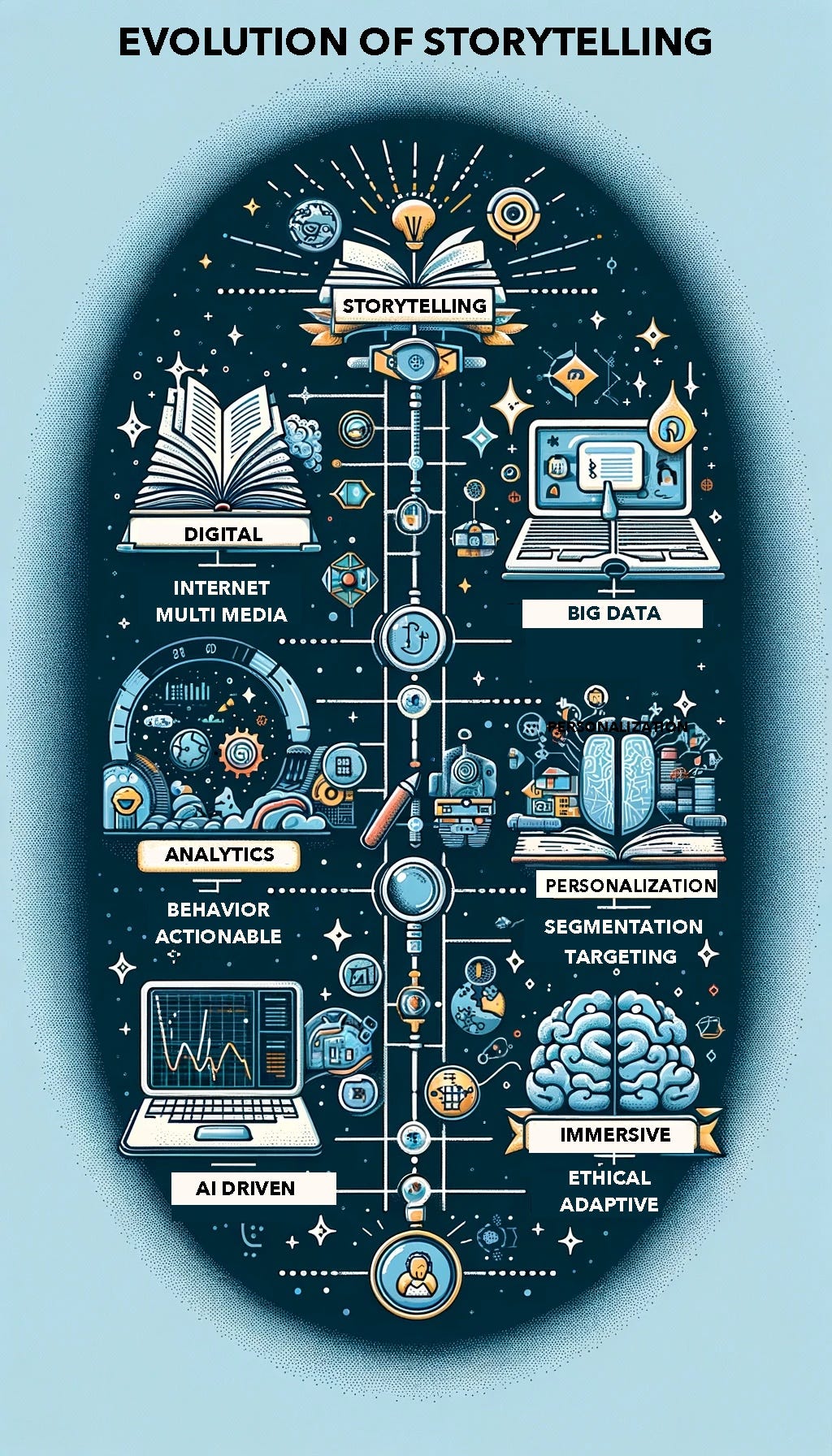In the fast-paced digital era, the art of storytelling in business has evolved beyond the traditional. Gone are the days when one-size-fits-all narratives dominated the marketing landscape. Today, the fusion of data analytics and narrative crafting has ushered in a new dawn of personalized storytelling — a strategy that not only captivates but also resonates with the individual preferences and behaviors of the audience.
This shift is not merely a trend but a transformative movement, propelled by technological advancements and the abundance of data at our fingertips. As a storyteller at heart and a tech wizard by profession, I’ve observed how data is not just numbers and statistics; it’s the voice of the customer waiting to be heard and understood. In this article, we will delve deep into the role of data in crafting compelling narratives, explore how businesses are leveraging this powerful duo to engage customers, and navigate the ethical considerations that come with this territory.
Section 1: The Evolution of Storytelling in Business
Storytelling has always been an integral part of human culture, and its significance in business is no exception. Traditionally, businesses used storytelling to build a brand image, communicate values, and connect with customers on an emotional level. However, the approach was largely generalized, based on broad market trends and demographic insights.
The digital revolution changed the game. The advent of big data, coupled with sophisticated analytical tools, has provided businesses with deep insights into individual consumer behaviors, preferences, and expectations. Netflix’s recommendation engine is a prime example of this shift. By analyzing viewer data, Netflix doesn’t just suggest random shows; it crafts a unique narrative for each user, suggesting titles that reflect their individual viewing habits and preferences.
The evolution from traditional storytelling to data-driven personalized narratives marks a significant transformation in how narratives are crafted and experienced. Here’s a breakdown of each key milestone in this evolution:

1. Traditional Storytelling:
— Definition: This era was characterized by one-way communication where stories were created based on general audience insights and broadcasted to a wide audience without personalization.
— Highlight: Stories were more generic, aiming to appeal to broad demographics, and were mostly delivered through traditional media such as books, newspapers, and television.
2. Digital Storytelling:
— Definition: The rise of the internet and digital platforms introduced a new way of storytelling where content could be more interactive and multimedia elements could be integrated.
— Highlight: The transition to digital media allowed for more dynamic content delivery and interaction with the audience but still lacked deep personalization.
3. Introduction of Big Data:
— Definition: The advent of big data technologies allowed for the collection and processing of large, complex datasets, providing deeper insights into audience behaviors and preferences.
— Highlight: Businesses and content creators began to understand and leverage audience data to inform their storytelling, leading to more targeted content but not yet fully personalized narratives.
4. Advent of Analytics Tools:
— Definition: The development and accessibility of sophisticated analytics tools enabled the extraction of actionable insights from big data.
— Highlight: These tools allowed storytellers to understand patterns and trends in audience behavior, enabling them to tailor their content more effectively to audience segments.
5. Personalization and Segmentation:
— Definition: With the insights gained from analytics, content could be segmented and personalized to cater to the specific interests, behaviors, and preferences of different audience groups.
— Highlight: This marked a shift from broad targeting to more individual-focused content, where narratives began to resonate more deeply with specific audience segments.
6. AI-driven Personalized Narratives:
— Definition: The integration of Artificial Intelligence and machine learning technologies took personalization to an individual level, where content could be tailored for each user based on their unique data.
— Highlight: AI algorithms analyze user data in real-time to deliver highly personalized content, transforming storytelling into an individualized experience where each narrative is as unique as the user itself.
7. The Future — Ethical, Adaptive, and Immersive Storytelling:
— Definition: As we look forward, the future of storytelling is anticipated to be not only data-driven and personalized but also ethical, adaptive, and more immersive.
— Highlight: With advancements in technology like AR, VR, and the continuous evolution of AI, coupled with a growing emphasis on ethical data use, storytelling is expected to become even more immersive and adaptive, providing experiences that are not only personalized but also responsible and profoundly engaging.
This evolution highlights the journey from generalized narratives to highly individualized stories, driven by technological advancements and a deeper understanding of human behavior and preferences.
Section 2: Understanding Data Analytics
At the core of personalized storytelling is data analytics — a discipline that examines raw data to draw conclusions about information. But not all data is created equal. In the realm of narrative crafting, three types of data take center stage:
1. Demographic Data: Basic information that categorizes consumers into groups based on age, gender, income, etc.
2. Behavioral Data: Insight into consumer behaviors, like purchase history, product usage, and interaction with online content.
3. Psychographic Data: Deep dive into the attitudes, interests, values, and lifestyle of consumers.
The power of data analytics lies in synthesizing these diverse data sets to form a holistic view of the consumer. Businesses use various tools and technologies, from simple analytical software to sophisticated AI algorithms, to interpret this data. For instance, Amazon’s recommendation engine not only suggests products based on your past purchases but also considers products you’ve browsed, ratings you’ve given, and what other customers with similar behaviors have liked.
Section 3: The Mechanics of Crafting Data-Driven Narratives
Understanding the mechanics of data-driven narratives is crucial for businesses aiming to capture the hearts and minds of their audience. It’s a process that involves collecting data, deriving insights, and ultimately, weaving these insights into personalized stories.
Translating Data into Stories:
The journey begins with data collection, but the magic lies in the interpretation. Advanced analytics and AI come into play here, transforming raw data into actionable insights. For instance, Spotify’s “Year in Review” feature provides users with a personalized story of their listening habits over the year, creating a unique and engaging experience.
Audience Segmentation:
One size does not fit all in the realm of personalized storytelling. Businesses segment their audience based on the data collected, allowing them to tailor narratives that resonate with each subgroup. Coca-Cola’s “Share a Coke” campaign is a classic example, where personalization drove the narrative by featuring popular names on bottles, making customers feel uniquely recognized.
Leveraging Multimedia:
In crafting narratives, the medium is as important as the message. Data-driven storytelling isn’t confined to text; it spans across videos, infographics, and interactive content. The New York Times, for example, often uses data visualization to tell compelling stories, making complex data digestible and engaging for their readers.
Case Studies in Data-Driven Storytelling:
- Starbucks Rewards App: By analyzing purchase data, Starbucks offers personalized deals and recommendations, turning every cup of coffee into a tailored customer experience.
- Nike’s Customized Shopping Experience: Nike uses data from its app to offer personalized product recommendations and workout plans, creating a narrative that’s not just about selling products but promoting a lifestyle.
Section 4: The Power of Personalization
The power of personalization lies in its ability to forge a deeper connection with the audience. Personalized narratives make consumers feel understood and valued, translating into tangible benefits for businesses.
Psychological Impact:
Personalization taps into the desire for recognition and relevance. When content resonates personally, it not only captures attention but also fosters an emotional connection, increasing brand loyalty and trust.
Business Benefits:
Personalized narratives are more than a marketing strategy; they are a business imperative in the digital age. They drive engagement, enhance customer satisfaction, and ultimately, boost sales. A study by Epsilon found that 80% of consumers are more likely to make a purchase when brands offer personalized experiences.
Addressing Challenges:
While personalization offers numerous benefits, it’s not without challenges. Over-personalization can lead to privacy concerns, and there’s a fine line between relevant and intrusive. Balancing personalization with privacy is the key to crafting narratives that respect the consumer while providing value.
Section 5: Navigating the Ethical Landscape
As businesses tread deeper into the realm of personalized storytelling, the ethical implications of data usage become increasingly significant.
Importance of Data Privacy:
In an era where data is the new currency, protecting consumer privacy is paramount. Businesses must navigate the complex landscape of data protection regulations, like GDPR and CCPA, ensuring transparency and consent in their data practices.
Best Practices:
Adopting best practices in data ethics is not just a legal obligation but a brand imperative. This includes obtaining explicit consent, providing clear opt-out options, and using data solely for the intended purpose.
The Future of Personalized Narratives:
As we look towards the future, the intersection of ethics, technology, and storytelling will continue to evolve. Businesses that prioritize ethical data practices and innovative storytelling will lead the way in creating narratives that resonate on a personal level while safeguarding consumer trust.

Conclusion:
As we stand at the crossroads of data and narrative, the transformative potential of this convergence is undeniable. The art of storytelling, once bound by the limitations of broad-brush approaches, is now free to explore the rich tapestry of individual preferences, behaviors, and emotions through data analytics. This evolution marks a significant leap from storytelling to storycrafting, where each narrative is meticulously woven with the threads of data insights, offering a tapestry of experiences that are as unique as the individuals they engage.
However, with great power comes great responsibility. The ability to craft personalized narratives through data opens up a world of possibilities, but it also calls for a renewed commitment to ethical practices and respect for privacy. As storytellers and innovators, we must tread this path with diligence, ensuring that our narratives are not just compelling but also conscientious, honoring the trust that our audiences place in us.
In this digital age, where every click, every view, and every interaction is a stanza in the story of consumer behavior, businesses have an unprecedented opportunity to connect with their audience on a deeply personal level. Data-driven storytelling is not just a tool; it’s a bridge — a bridge that connects businesses with their customers, fostering a relationship that is built on understanding, relevance, and respect.
Next Steps:
1. Reflect on Your Narrative: Take a moment to consider your current storytelling strategies. Are they speaking to your audience, or are they merely speaking at them? The shift from generic narratives to personalized stories is not just a change in content; it’s a change in mindset.
2. Embrace the Data: If you haven’t already, start integrating data analytics into your narrative crafting process. Begin with the data you have, whether it’s customer feedback, website analytics, or social media engagement. Look for patterns, preferences, and passions that resonate with your audience.
3. Prioritize Privacy: As you embark on this journey of personalized storytelling, make privacy and ethical data usage your cornerstones. Respect for your audience’s privacy is not just a legal obligation; it’s the foundation of trust and loyalty.
4. Stay Curious, Stay Innovative: The landscape of data-driven storytelling is ever-evolving. Keep your pulse on the latest tools, technologies, and trends. But more importantly, keep your heart attuned to the stories that your data is telling you.
The future of storytelling is here, and it’s data-driven. It’s a future where every narrative is a mirror, reflecting the individuality of its audience. As you step into this future, carry with you the wisdom of the past, the insights of the present, and the vision for a future where every story is not just told but felt, not just heard but lived.
Absolutely, Tony! A strong call to action (CTA) can effectively engage your readers and encourage them to connect with you. Here’s a suggestion for a compelling CTA to conclude your article:
In today’s digital narrative, the threads of data and personalization weave stories that are not just told but experienced. As we stand at the precipice of this new era of storytelling, the question isn’t if we will adapt, but how swiftly and innovatively we will embrace this transformation.
If you find yourself at the crossroads, pondering how to harness the power of data-driven narratives to captivate, engage, and resonate with your audience, let’s navigate this journey together. With a blend of storytelling prowess and tech-savviness, I am here to guide you through the labyrinth of data, insights, and narratives, turning your vision into impactful, data-driven storytelling experiences.
Don’t let your story remain untold or your data unexplored. Reach out to me, and let’s embark on a journey to transform your narratives, engage your audience on a deeper level, and carve a niche in the ever-evolving landscape of digital storytelling. Your story deserves to be heard, and together, we can ensure it echoes across the digital expanse.
If you enjoyed this article, discover more insights and narratives on my Medium page at https://tonyleonard.medium.com/ — I look forward to sharing more with you!


